NEC PA271W - When Accuracy and Consistency Matter
by Chris Heinonen on May 1, 2012 1:55 PM ESTNEC PA271W - Color Quality and Color Gamut
Targeted directly at designers and other graphics professionals, we’d expect to see excellent performance, hopefully before and after calibration from the NEC. For the initial measurements, with so many options available, I used the included ICC profile and set the monitor to sRGB mode as well as 200 nits of light output.
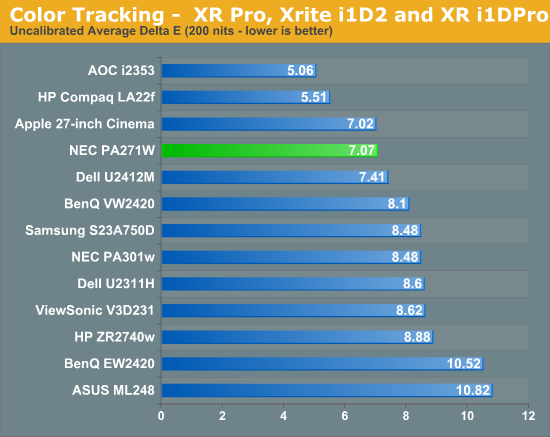
Pre-calibration we get an error of 7.07, which is a bit higher than I thought it would be, with a really high error in the grayscale. Overall this was OK, but I highly doubt many people will buy this display without choosing to calibrate it given its target market. Our target settings were a 2.2 gamma, D65 white point, and 200 nits of light output. ColorEyes Display Pro doesn’t give a color gamut option, so I assume it is targeting the native gamut of the display.
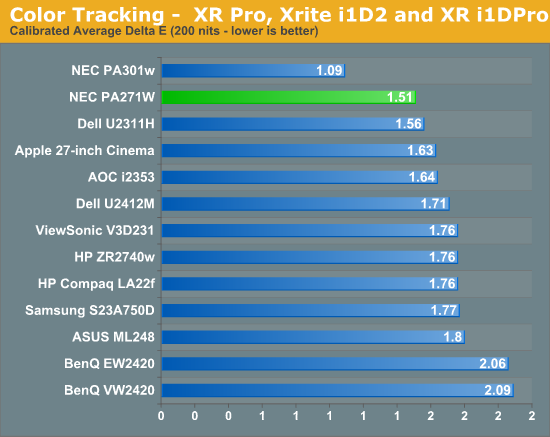
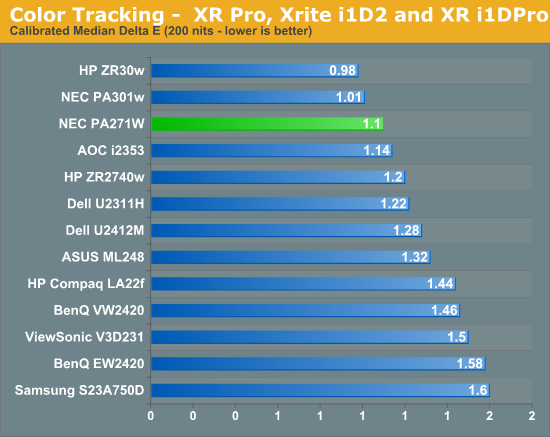
This is much better after a calibration, with an average dE of only 1.51 and a median dE of just under 1.1. You’ll notice the last color sample before pure white, a turquoise blue, has a much lower error here than on most displays. This is the shade of blue that actually lies outside of the sRGB colorspace and so most displays cannot reproduce it, leading to a very high dE there. The only panel to do better recently is the 30” NEC that has a true 10-bit panel.
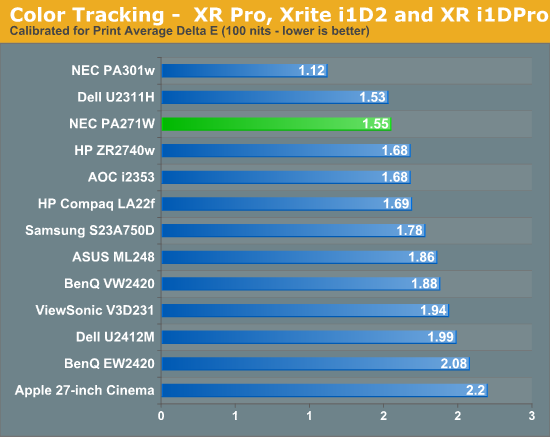
As the print market is a main area for NEC to target with this display, its performance with 100 nits of light output is of more importance than usual. Here we find that the NEC performs almost identically to its 200 nits results, which is actually quite good. As many displays get better or worse as the light output changes, that indicates they will only perform at their best at a certain light level, whereas if you are consistent the user can set the light to match their environment. The NEC doesn’t run away from the competition in any of these tests, but it performs very well, and very consistently.
You won't be lacking for gamut here either, as the NEC covers over 109% of the AdobeRGB gamut, meaning that for any work you are doing, even including something like DCI Cinema, the NEC has you covered.
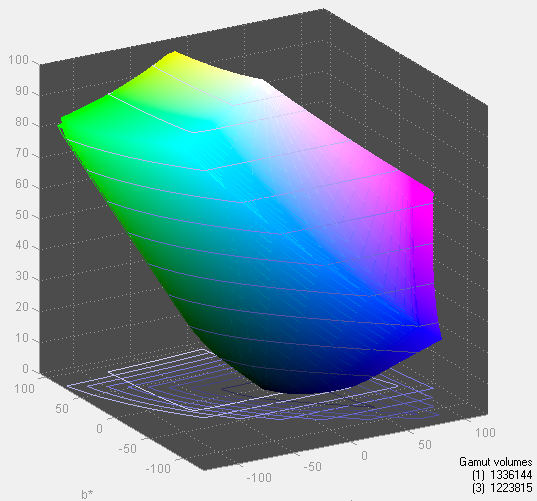
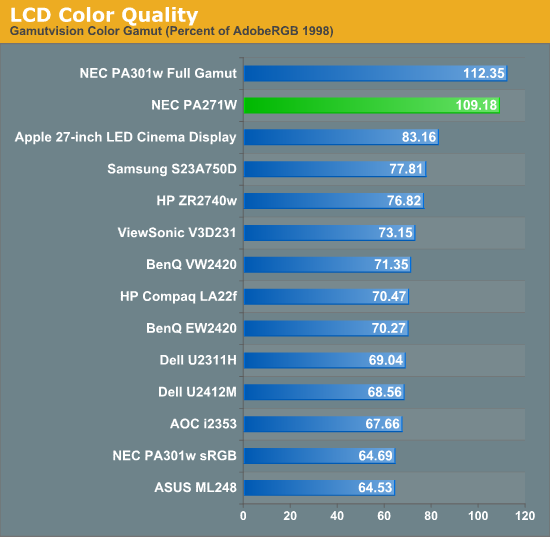


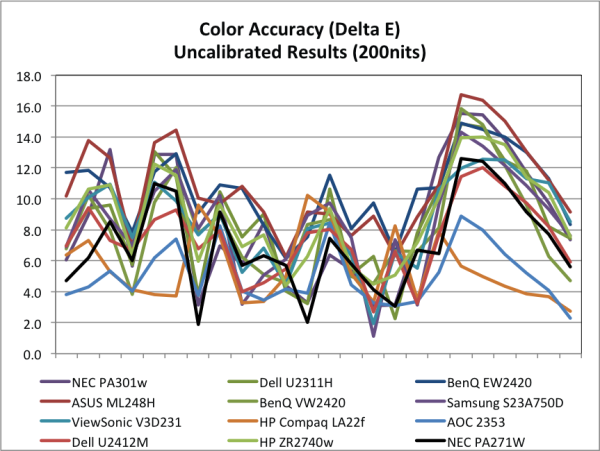
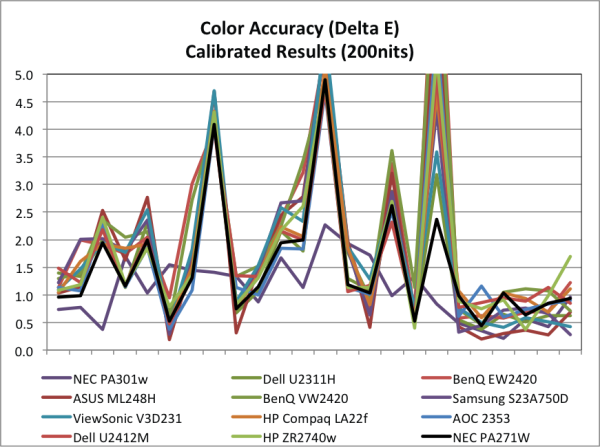









69 Comments
View All Comments
cheinonen - Tuesday, May 1, 2012 - link
And that's why in the conclusion I have a section that reads "If you are a design professional who needs accurate color more than anything else, and things like display uniformity and a wider gamut are of high importance, then you are the target for the NEC. You already know you might need this, which features you can’t live without, and are willing to pay the extra price."I'm not discounting it because of my use or because I'm not a hard core gamer, I'm drawing the conclusion that if you aren't in that target audience that I already covered in the conclusion, there are other monitors that likely offer a better price/performance ratio for you, or in the case of gaming that offer better performance overall. I tried to cover in depth all of the extra features that design industry professionals would use, as that is the target for the monitor, but also cover it for a general audience as well.
analogworm - Wednesday, May 2, 2012 - link
Chris,In this review you state Nec as being top of the line for graphics proffessionals. Ofcourse your review fully supports this statement, and i have no doubt the nec does a wonderful job. However i miss comparisons to the EIZO monitors, as ive been thought EIZO is top of the line for graphical use, albeit a wee bit more expensive. Could you review one of eizo's monitors for comparison? Id very much appreciate it.
kind regards,
Analogworm
Origin32 - Wednesday, May 2, 2012 - link
How I wish some manufacturer would come along with a 120Hz 2560x1440 monitor already. It's not that not having 3D is such a dealbreaker, but it is awesome and the 120Hz is actually useful in 2D FPSs too. It noticeably improved my performance when I got my Acer GD245HQ 18 months ago.So going back to 60Hz really wouldn't be much of an upgrade, even if I got more pixels.
Oh, and I know 120 is going to be expensive. But I'm more than willing to sell my mother for one.
AeroWB - Wednesday, May 2, 2012 - link
I have an PA241W, which closely resembles the PA271W. My main problem with it is the mediocre black-levels. The black-levels are fine if its standing in an well lit office though. At home the room often isn't so well lit and then it is fairly obvious that the blacks are worse then of the older IPS NEC screens like the 2090UXi which I use as a second monitor. This difference is because the newer models do not use the A-TW polarizer film. According to NEC the polarizer film was dropped as it increased the color-shift that occurs when looking at the display from the side.What I love about he unit is the great color gamut which can make pictures more alive, and when working with sRGB I only have to press one button on the monitor to switch between color-modes.
The portrait mode is great option which I do use regularly.
Next to that I do use it to game and while I do not play the fastest FPS games, anything non-FPS is not a problem and I even play Battlefield 3 without any problems, maybe the 24" model has a slightly lower input lag then the 27" though the 24" does also have an input lag that is higher then most other displays, so the difference can't be big.
MrSpadge - Wednesday, May 2, 2012 - link
The first paragraphs, which show up in the front page, may be a nice general introduction, but say absolutely nothing about the product - not good for the front page.svojoe - Wednesday, May 2, 2012 - link
I'm curious why they used CFL's? I personally feel that the decent LED back light put out a more even and brighter color than the CFL's. At half the power consumption. 110Watts is more draw than my whole computer!I would have otherwise been very interested in this!
DanNeely - Wednesday, May 2, 2012 - link
The best CFLs still have wider gamut and lower deltaE than the best LED backlights. Although other people buy them, the 2560 monitor market in general and NEC (among others) in particular are targetting profesional graphics/image/video editing customers for whom color quality is a much larger priority than saving $20/year on their power bill.kmmatney - Wednesday, May 2, 2012 - link
Overall, it seems like the Apple 27" is better - and cheaper even factoring in the $30 DVI adapter, while coming close to it in color quality.cheinonen - Thursday, May 3, 2012 - link
With any of the 27" panels tested so far you could say they are "close" to the NEC, but for some people they need that extra bit of quality and uniformity for their work, irregardless of cost. It costs a lot more to get it since it takes a lot more work and engineering, but for some people it's a necessity.nurfe - Thursday, May 3, 2012 - link
Except that Apple won't support 14 bit lookup-tables, hardware calibration, and it won't electronically correct uniformity and colour variation problems. If nothing I mentioned matters to you, go for something cheap. If you care about it, you'll get a NEC, EIZO or Quato.